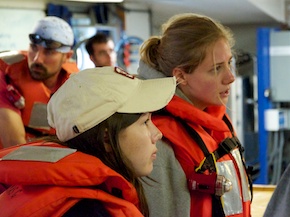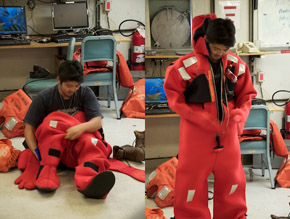The R/V Thomas G. Thompson left Honolulu on November 5, 2011 heading toward the Western Pacific. This expedition journal was written by cruise participants and uploaded about once per weekday, depending on internet availability.
November 8, 2011: Shipboard Safety Orientation

Paying attention (Credit: Will Koeppen)
The first day on the boat, we met the captain, first mate, and third mate to carry out a ship's safety orientation. The orientation covered three procedures that would occur during three scenarios: fire, abandon ship, or man overboard.
In case of a fire, a continuous alarm sounds, ringing without pause. In that situation, the science party gets lifejackets from their rooms and musters in the main lab where the tech team takes attendance. After that, the science party is expected to either stay in the main lab, or go to the back deck of the boat, depending on the location of the fire. If the fire occurs in the main lab, then the science party meets on the back deck of the ship and attendance is taken there. The first and third mates showed us how to use an emergency escape breathing device and walked us through the emergency escape routes for both the aft and forward berthing sections.
If an abandon ship situation occurs, an alarm would be set off which would be six short rings followed by one long sounding. Then the science party brings their life jackets and their immersion suits from their rooms to the main lab where attendance is taken. Afterwards, the science party goes to the life boats. The immersion suits (a.k.a. gumby suits) may need to be used, especially when the boat is in colder waters. Since the waters here are warm, they are not necessary, but some people may prefer to use them. It is not easy to get into an immersion suit. First you unzip it and roll it out onto a flat surface such as a floor. Then you sit on top of the unzipped part of the suit and put your legs inside while sitting. Sitting on the suit is easier than standing up due to the rocking of the boat, which can throw off your balance. After putting your legs into the suit, you may stand up, put your hands inside, pull the hood over your head, zip up the suit, and then pull the strap over your face. You can manually inflate the immersion suit, if necessary.

Justin Fujii demonstrates the immersion suit
(Credit: Will Koeppen)
The last situation covered during the orientation was the man overboard procedure. If someone, either crew member or science group member, spots a person in the water, they keep eye contact with them and yell to someone else to call the bridge. Once the bridge gets the call, they will sound the man overboard alarm (three long soundings, repeated four times). The spotter tries to never lose sight of the person overboard. If you are not the spotter (or the person overboard!), you meet in the main lab to make sure everyone is else is present.
After the safety orientation, there was a drill for each situation to make sure the science party knew what to do if the alarm ever goes off. ♦
